Mushrooms
Media
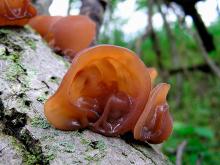
Species Types
Scientific Name
Auricularia auricula (formerly A. auricula-judae)
Description
The wood ear is a reddish brown to grayish black, rubbery, earlike or cup-shaped mushroom. It usually grows in groups on rotting wood.
Media

Species Types
Scientific Name
Desarmillaria caespitosa (formerly Armillaria tabescens)
Description
The ringless honey mushroom is honey-colored, with a dry, scaly cap, and lacks a ring on the stalk. It grows in clusters at the bases of trees or stumps, especially of oaks, and over buried wood.
Media
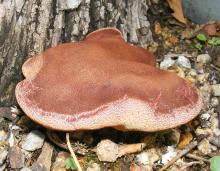
Species Types
Scientific Name
Fistulina hepatica
Description
The beefsteak polypore is a thick, semicircular, reddish or rusty, gelatinous bracket with a pinkish yellow underside. It grows at the base of living oaks and on stumps.
Media
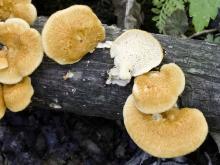
Species Types
Scientific Name
Polyporus alveolaris (formerly Favolus alveolaris)
Description
This polypore is an orange to tan, fan-shaped bracket that is scaly on top; the underside has rows of white, six-sided, radially arranged pores. It grows singly or in groups on dead branches of deciduous trees.
Media

Species Types
Scientific Name
Artomyces pyxidatus (formerly Clavicorona pyxidata)
Description
The crown-tipped coral is a many-branched, coral-like mushroom that is yellowish tan with crownlike tips. It grows on the dead wood of deciduous trees.
Media

Species Types
Scientific Name
Phallus ravenelii
Description
Ravenel's stinkhorn is a long, whitish column with a greenish, smelly slime covering the top, and a whitish or pinkish cup around the base. It grows on wood debris, mulch, rotted stumps, and sawdust, and in deciduous woods.
Media
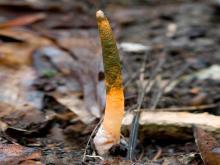
Species Types
Scientific Name
Mutinus elegans
Description
The elegant stinkhorn is a long, tapered, pinkish orange column with a greenish brown, smelly slime covering the top and a white cup around the base. It grows on leafy debris, mulch piles, and rotting wood.
Media
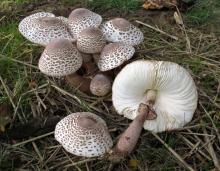
Species Types
Scientific Name
Leucoagaricus americanus (Lepiota americana)
Description
The reddening lepiota is a large, reddish brown mushroom with a scaly cap and a ring on the stalk; it bruises dark red. It grows singly or in clusters in mulch piles, waste areas, and around stumps.
Media

Species Types
Scientific Name
Pluteus atricapillus (formerly P. cervinus)
Description
The fawn mushroom has a brownish gray cap with whitish to pinkish gills and a whitish stalk. It grows singly or scattered, on dead wood or on the ground over buried wood.
See Also



Media

Species Types
Scientific Name
Monotropa hypopitys
Description
Pinesap is a plant that puts the "wild" in wildflower! It lacks chlorophyll, so its roots connect to fungi underground and absorb nutrients from the fungi.
Media

Species Types
Scientific Name
Cladophora, Pithophora, and Spirogyra spp., and others
Description
Filamentous green algae forms green, cottony masses that are free-floating or attached to rocks, debris, or other plants.
Media

Species Types
Scientific Name
Monotropa uniflora
Description
Indian pipe lacks chlorophyll, so it is white, not green. Below ground, its roots join with fungi that connect to tree roots. This plant, then, takes nourishment indirectly from the trees.
About Mushrooms in Missouri
Mushrooms are a lot like plants, but they lack chlorophyll and have to take nutrients from other materials. Mushrooms are neither plants nor animals. They are in a different kingdom — the fungi. Fungi include the familiar mushroom-forming species, plus the yeasts, molds, smuts, and rusts.
Always be cautious when eating edible mushrooms. Be absolutely sure of the ID, and only eat a small amount the first time you try it to avoid a reaction..





















